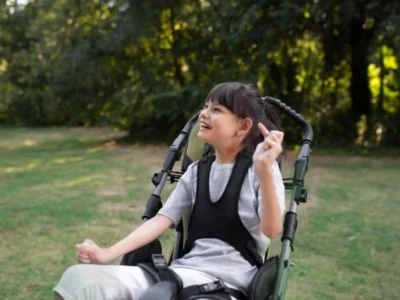Neuropsychologist Lidia García Pérez explains in this article what aphasia is, the types of aphasia and distinguishes between this disorder and speech disorders, dysarthria and cognitive-communicative impairment.
What is aphasia?
Aphasia is a loss or language disorder caused by brain damage [1] that is typically associated with lesions in the hemisphere dominant for language (the left hemisphere for 96% of right-handed people and 70% of left-handed people [2]).
The term derives from the Greek ἀφασία which means “inability to speak” [3]; however, this disorder can affect, in various ways and to differing degrees, both language production and comprehension, in any of its modalities: spoken expression, spoken comprehension, writing or reading [4,5].
Therefore, within it very heterogeneous syndromes can be described depending on the linguistic abilities that are affected, which may also coexist with other cognitive deficits.
Aphasia, speech disorders and communication disorders
Since the language disorder that involves aphasia also implies a decline in communication ability, it is important to distinguish between this disorder and other types of communication impairments due to acquired brain damage or not, such as speech disorders and neuropsychological disorders like apraxia of speech or cognitive-communicative impairments[4].
Aphasia vs. speech disorders
Speech disorders, such as dysphonia, stuttering, dysglossia, dyslalia or dysarthria, are alterations of different origins (buccophonatory or neurological) that affect various parameters of speech, such as the acoustic qualities of the voice (intensity, pitch and timbre), fluency, pronunciation or articulation of phonemes and words, but in which language is preserved [5].
Aphasia, by contrast, is characterized by an alteration in the structure of language that affects its semantic, grammatical, phonological and/or syntactic level, which deteriorates its symbolic nature [5], that is, language’s capacity to represent ideas or thoughts. Therefore, while this disorder consists of a specific deterioration of language that affects its oral modality and the ability to communicate, speech disorders also affect communication but not language.
In some cases, aphasia may be accompanied by apraxia of speech, which like aphasia is an acquired neuropsychological disorder due to brain damage and consists of difficulty carrying out the voluntary articulatory movements of speech, due to a lesion in cortical motor association areas responsible for programming the voluntary movements of the musculature of the mouth, tongue and larynx [2,5]. Although some aphasic profiles, such as non-fluent aphasias, may include apraxia of speech as a symptom, apraxia of speech itself is a problem of kinetic planning.
In clinical assessment apraxia of speech can be distinguished by the difficulty moving the muscles of the mouth, tongue and larynx in tasks other than speaking [2], such as swallowing, blowing, whistling, chewing or kissing.
Aphasia vs. dysarthria
Another useful distinction is the one that can be made between apraxia of speech and dysarthria, which is a neuromuscular disorder in which the execution of speech movements is also impaired, affecting articulation, but not due to a problem in movement planning, rather due to activation of the muscles involved.
Clinically, they are distinguishable in that, in dysarthria, there is consistency in articulation errors and the influence of word length is smaller, whereas in apraxia of speech word length influences errors more and these are not consistent [4]. In addition, in apraxia of speech there is an automatic-voluntary dissociation [4] (for example, the patient may have difficulty smiling consciously, but will be able to smile spontaneously).
Aphasia vs. cognitive-communicative impairment
On the other hand, when we speak, listen, read or write, not only linguistic aspects are involved, but these abilities require other cognitive functions such as attention, memory, executive functions, reasoning or abstraction [4].
Therefore we must be able to distinguish between a primary language problem (aphasia) and language problems secondary to deficits in those other functions, which have been called cognitive-communicative impairments and affect behavior regulation, social interaction, activities of daily living, learning and academic and professional performance [4].
Types of aphasia
An initial classification criterion, useful in the differential diagnosis of types of aphasia, is usually the distinction between fluent aphasia and non-fluent aphasia[7]. When it is non-fluent, expressive language is less preserved than comprehension and when the opposite occurs it is considered fluent [5].
Non-fluent aphasias
According to the classical classification of the different types [4, 7], the non-fluent ones include Broca’s aphasia, transcortical motor aphasia and global aphasia; and the fluent ones include Wernicke’s aphasia, transcortical sensory aphasia, conduction aphasia and anomic aphasia.
Patients with Broca’s aphasia usually show difficulties in spontaneous speech, little fluency, telegraphic language, agrammatisms (grammatical and syntactic errors) and difficulties in naming and repetition, while comprehension is relatively better preserved [5,6]. When the patient shows a similar profile but does not present repetition problems, it is classified as transcortical motor aphasia [6].
In global aphasia there are severe problems in both comprehension and production [5,6].
Fluent aphasia
In Wernicke’s aphasia comprehension and naming are severely affected and oral expression is fluent, but with abundant paraphasias (incorrect constructions or substitutions of some words for others) and neologisms (nonexistent words) [5,6]. In transcortical sensory aphasia, the patient presents the problems of Wernicke’s aphasia except for the difficulty in repetition [6].
When difficulty in repetition is the main problem, it is classified as conduction aphasia. In anomic aphasia there is only a deficit in naming.
Although this classification is probably the most widespread, the differential diagnosis of aphasias, by this or any other taxonomy of syndromic groups, presents some limitations in practice, which is a topic that will be addressed in a future post.

Subscribe
to our
Newsletter
Bibliography
- Ardila, A. & Benson, D. F. (1996). Aphasia: A clinicalperspective. New York: Oxford.
- Scott J. G. y Schoenberg, M. R. (2011). Languageproblems and assessment: theaphasicpatient. En Schoenberg, M. R. & Scott J. G. (Eds.). The little black book of neuropsychology: a syndrome-basedapproach (p. 159-178).New York, Dordrecht, Heidelberg, London: Springer.
- Real Academia Nacional de Medicina (2012). Diccionario de términos médicos. Madrid: Panamericana. Recuperado de http://dtme.ranm.es/ingresar.aspx
- Gispert-Saúch, M. M. (2011). Lenguaje, afasias y trastornos de la comunicación. En Bruna, O., Roig, T., Puyuelo, M., Junqué, C. y Rueano, A. (Eds.). Rehabilitación neuropsicológica: intervención y práctica clínica (p. 61-81). Barcelona: ElsevierMasson.
- Portellano, J. A. (2010). Introducción a la neuropsicología. Madrid: McGraw Hill.
- Cuetos, F., González, M., Martínez, L., Mantiñán, N., Olmedo, A. y Dioses, A. (2010). ¿Síndromes o síntomas en la evaluación de los pacientes afásicos? Psicothema, vol. 22(4), pp. 715-719.
- Ardila, A. y Roselli, M. (2007). Neuropsicología clínica. México, D. F.: El Manual Moderno.
If you liked this article about aphasia, you might also be interested in:
“This article has been translated. Link to the original article in Spanish:”
Afasia: diagnóstico diferencial y tipos de afasias







 Cognitive mechanisms of errorless learning
Cognitive mechanisms of errorless learning
Leave a Reply